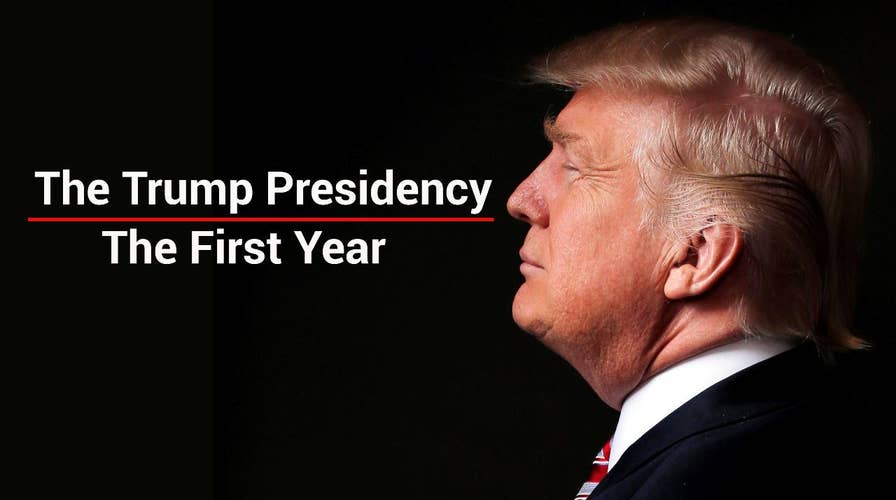President Trump's first year in office: A look back
January 20, 2018 marks the one year anniversary of President Trump taking office. Here is a look back at the ups and downs of 365 days unlike any other in American politics.
As we look back on the first year of the Trump presidency and take stock, this much is clear: President Trump has enjoyed some political successes, but has made little progress at uniting our deeply divided country.
While some may focus their criticism on his controversial tweets or provocative comments, the larger concern about President Trump is his divisive method of governing.
Historically, most presidents who are narrowly elected recognize that their primary responsibility to bring the nation together. When John F. Kennedy won by the thinnest margin of any U.S. presidential election up to that time, his inaugural address acknowledged it was “not a victory of party but a celebration of freedom.”
Similarly, after George W. Bush, like President Trump, won the election but lost the popular vote, he pledged to work with former rival Al Gore “to do our best to heal our country.”
In his 2016 victory speech, President Trump similarly promised to be “president for all Americans” and called on all parties to “bind the wounds of division” in order to “come together as one united people.” But since that time, the president has only catered to the needs of a single constituency – his base – and to the exclusion of all other groups.
President Trump must commit himself to consistently cooperate across party lines and work on behalf of all Americans – even those who did not vote for him. If he does, his accomplishments can defend Republican seats in the November midterm elections and enhance chances for GOP victories in 2020.
Despite his reluctance to act as uniter-in-chief, President Trump has achieved several notable accomplishments during his first year in office. If the president is able to shift his governing style to be more consistent and inclusive, taken with his accomplishments, this display of leadership would propel him towards a victory in 2020.
For instance, the economy has undeniably surged under President Trump. The Dow Jones industrial average recently reached 26,000 for the first time. In December, the national unemployment rate fell to 4.1 percent, the lowest level since 2010.
The newly-signed GOP tax cuts are an important achievement for President Trump. Approximately 46 percent of Americans approve of the tax law, according to a mid-January New York Times survey. For the first time in years, companies are able to give bonuses to their employees – and they’re crediting the tax overhaul.
In response, consumer confidence has skyrocketed. Now 42 percent of Americans believe the national economy is better than it was a year ago, according to the New York Times poll.
Yet President Trump continues to vacillate between appeasing his base and throwing rhetorical bones across the aisle, leaving little room for bipartisan negotiation or compromise.
On his signature issue of immigration, President Trump conveyed dramatically mixed messages. In early January, he called on Congress to pass a “bill of love” to resolve the fate of the DACA (Deferred Action for Childhood Arrivals) program and strengthen immigration policy.
Under DACA, about 700,000 immigrants brought to the U.S. illegally as children are temporarily allowed to stay. However, President Trump is seeking to end the program, which was created under an executive order issued by President Obama, unless Congress votes by early March to give DACA recipients legal status.
Unfortunately, when a bipartisan group of senators reached an agreement several days ago providing a path to citizenship for DACA recipients and increased funding for border security – a good deal for both parties – the president waffled. He called the proposal a “big step backwards,” said DACA was “probably dead,” and that the Democrats were to blame.
Potential infrastructure plans are similarly waylaid by President Trump’s flip-flopping. His insistence on funding for a southern border wall – contradicted by Chief of Staff John Kelly’s suggestion that the president had “changed his attitude” – shifted yet again with President Trump’s claim that his position has “never changed or evolved.” Such waffling threatens the possibility of this major bipartisan project.
Ultimately, the American people are unhappy with President Trump’s fluctuations and divisiveness. According to a Quinnipiac University poll released January 17, 64 percent of voters believe the president is doing more to divide the country than to unite it.
The latest Real Clear Politics average of public opinion polls says 40 percent of Americans approve of the job President Trump is doing in office and 55 percent disapprove.
Ultimately, the lesson is simple: if an elected leader attempts to be inclusive, his or her approval ratings will go up. This was evident with President Clinton, with President George W. Bush after the Sept. 11, 2001 terrorist attacks, and with President Obama at the beginning of his term. A little unity can go a long way come election season.
President Trump must commit himself to consistently cooperate across party lines and work on behalf of all Americans – even those who did not vote for him. If he does, his accomplishments can defend Republican seats in the November midterm elections and enhance chances for GOP victories in 2020.
During his 2016 election night speech, President Trump proved he knows how to unite Americans and inspire confidence. In one night, he singlehandedly created huge economic value as the Dow soared.
That was then, this is now. But the American people still want a president for all Americans.
If he can deliver, President Trump will triumph.

